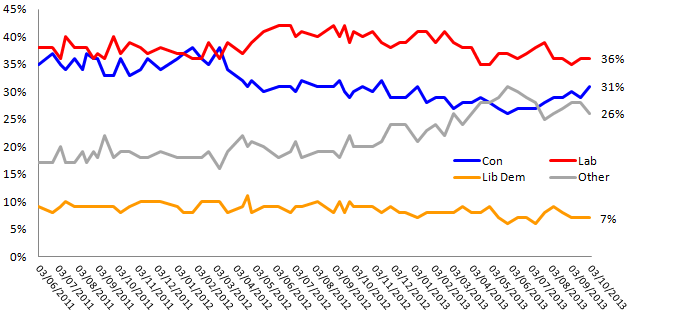Political Polling – 1st October 2013
1st October 2013
The aftermath of the party conferences is seen more in the approval ratings of the leaders than the vote shares of their parties.
Labour remain unchanged on 36%, as do the Lib Dems on 7% while the Conservatives climb two points to 31%, mirroring a two point drop for UKIP to 15%.


| † | % | Change |
| Conservative | 31 | +2 |
| Labour | 36 | n/c |
| Liberal Democrats | 7 | n/c |
| Other parties | 26 | -2 |
Other Parties (breakdown)
| † | % | Change |
| UKIP | 15 | -2 |
| Green | 4 | n/c |
| SNP | 4 | +1 |
| BNP | 2 | +1 |
| Plaid Cymru | 0 | -1 |
| Other | 1 | n/c |
Approval ratings
- Mr Cameron has climbed from 33% to 37% approval while the number who disapprove has dropped from 50% to 47%, taking his net rating from -17% to -10%
- Ed Miliband has also seen a jump in approval (24%, up from 21%) but the real change is the drop in the number disapproving (45%, down from 50%) which has seen his net approval rating rise to -21% after a prolonged dip

| † | % Approve | % Disapprove | Net rating | Net rating (own party) |
| David Cameron | 37% | 47% | -10% | +85% |
| Ed Miliband | 24% | 45% | -21% | +46% |
| Nick Clegg | 14% | 57% | -43% | +44% |
Opinium Research carried out an online survey of 1,948 GB adults aged 18+ from 1st to 4th October 2013. Results have been weighted to nationally representative criteria.
Interview Method and Sample
This survey is conducted online by CAWI (computer aided web interviewing), using Opinium?s online research panel of circa 30,000 individuals. This research is run from a representative sample of GB adults (aged 18+ in England, Scotland and Wales). The sample is defined from pre-collected registration data containing gender, age (18-34, 35-54, and 55+), region (North East, North West, Yorkshire and Humberside, East Midlands, West Midlands, East of England, London, South East, South West, Wales, and Scotland), working status and social grade to match the latest published ONS figures.
Opinium also takes into account differential response rates from the different demographic groups, to ensure the sample is representative.


